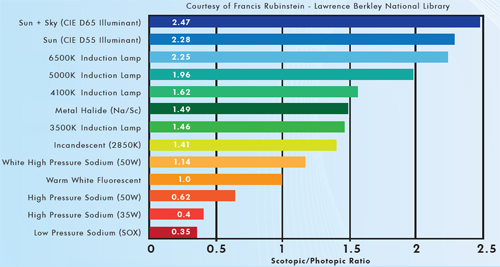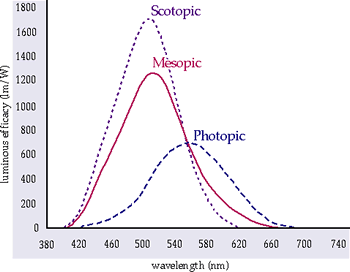Are all Lumens Equal? Consider how the human eye perceives light
Merging photopic, scotopic vision cuts energy costs, boosts visibility perception
The science of measuring light, in terms of how the human eye perceives its brightness, is called photometry.
The eye has two primary light-sensing cells in the retina, known as photoreceptors, called rods and cones, referring to their geometric shapes.
- Cones process visual information under daytime, or photopic light levels
- Rods are used in near-complete darkness, referred to as scotopic conditions
Photopic light levels have excellent color discrimination, where colors seem the same under scotopic vision.
… lamps with high S/P ratios provide sharper vision both outdoors and indoors. So, a 200-watt magnetic induction lamp would appear just as bright or brighter than a sodium vapor or metal halide of twice the wattage.
The ratio of scotopic luminance (or lumens) versus photopic luminance in a lamp is called the S/P ratio, which is a multiplier that determines the apparent visual brightness of a light source as well as how much light a lamp emits that is useful to the human eye, referred to as visually effective lumens (VELs).
Generally, lamps with high S/P ratios provide sharper vision both outdoors and indoors. So, a 200-watt magnetic induction lamp would appear just as bright or brighter than a sodium vapor or metal halide of twice the wattage.
Here’s the math showing a 50% energy reduction:
- A 400w Metal Halide lamp has a manufacturer’s rating of 54.6 lumens per watt; so, 400 x 54.6 = 21,840 lumens x 1.497 (S/P ratio) = 32,541 VELs.
- A 200w Induction lamp has a manufacturer’s rating of 81 lumens per watt; so, 200 x 81 = 16,200 lumens x 1.96 (S/P ratio) = 31,752 VELs.
Mesopic – combining rods and cones
Between photopic and scotopic light levels is a range called mesopic, which are low – but not dark – outdoor lighting conditions where both cones and rods combine photopic and scotopic response to process visual information. Most artificial light systems emit outdoor light levels in the mesopic range.
Now, as we mentioned in a previous article, the seven color bands produced when sunlight is refracted through a prism – red, orange, yellow, green, blue, indigo and violet – are part of the electromagnetic spectrum that’s visible to the human eye and all have different wavelengths.
To describe how the eye responds to those wavelengths, the lighting industry uses the term luminosity function, also called luminous efficiency function.
Photopic luminosity function best approximates the response of the human eye in daylight and scotopic luminosity function is used to describe the eye’s response to extremely low light (nighttime) levels.
Commercial photometry is important for lighting installers and their clients in choosing the best locations to install fixtures as well as ensuring maximum efficiency of lighting systems.
Problem is, commercial photometry only considers the photopic luminosity function, which was established in 1924 by the International Commission on Illumination (CIE), and has almost always been recognized as underestimating how the blue and violet end of the spectrum – where the eye shifts in scotopic conditions – contribute to perceived luminance.
In the past, lighting manufacturers used light meters to determine lumen output, or luminous efficacy, of a fixture in order to gain maximum energy efficiency. But these devices relied only on photopic conditions, in keeping with the decades-old assumption that light sensitive rods only kicked in at low-light, or nighttime, conditions.
For lighting installers and their clients, that meant the effectiveness of certain lighting products used in nighttime applications, such as street lighting, in terms of energy efficiency and visual safety, was being underestimated.
In addition, relying only on photopic luminous function to measure nighttime illuminations requires some light sources to use excessive energy to generate the necessary light level.
Realizing the potential cost-savings that an alternative measure of lighting scenarios could produce coupled with the fact that photopic and scotopic were not mutually exclusive and that rods were active, not only in low-light but also during interior light levels, researchers set out to develop a new measurement.
Bridging the gap between scotopic and photopic
Researchers at the Rensselaer Polytechnic Institute’s Lighting Research Center (LRC) developed a “Unified System of Photometry,” which integrates both the scotopic and photopic luminous efficiency functions into a measurement system that can be used for any light level, including mesopic, perceptible to the eyes.
LRC researchers estimated that about half of U.S. streetlights could cut energy consumption by about 50 percent – annually saving one billion kilowatt hours – using a Unified System of Photometry to design more energy efficient lamps, including LEDs, without sacrificing perceptions of visibility and safety.
Cutting energy consumption in street lighting
Field demonstration results in rural and suburban areas of Connecticut, Massachusetts, and Texas verified that by implementing the Unified System of Photometry the street lighting system consumed 30 to 50 percent less electric power and the residents believed they could see better and said they felt safer, when compared to lighting systems designed using the traditional system of photometry.
Commenting on the field tests, LRC’s Director of Energy Programs, Peter Morante, described how, in nighttime conditions, the human eye is more sensitive to short-wavelength light, which produces cool tones like blue or green, as opposed to long-wavelength light, which produces warm tones like yellow and red.
“By replacing traditional, yellowish high-pressure sodium (HPS) lights with ‘cool’ white light sources, such as induction, fluorescent, ceramic metal halide, or LEDs, we can actually reduce the amount of electric power used for lighting while maintaining or even improving visibility in nighttime conditions,” Morante said.
Sources for this article and further reading:
- http://www1.eere.energy.gov/buildings/spectrally_enhanced.html
- http://gaia.lbl.gov/btech/papers/42327.pdf
- http://www.lrc.rpi.edu/researchAreas/pdf/GrotonFinalReport.pdf
- http://knol.google.com/k/environmental-aspects-of-magnetic-induction-lamps
- http://www.gelighting.com/na/business_lighting/education_resources/literature_library/white_papers/download/photopic_scotopic_lb.pdf


